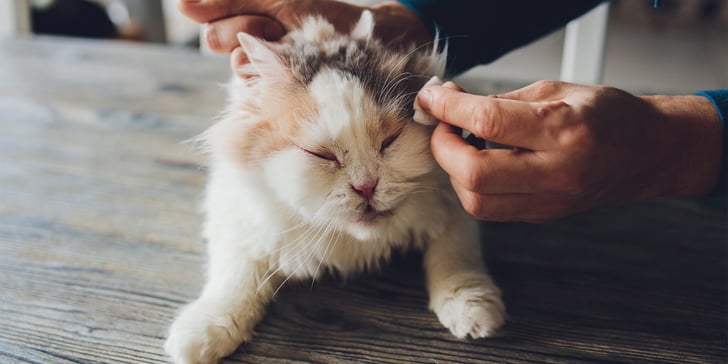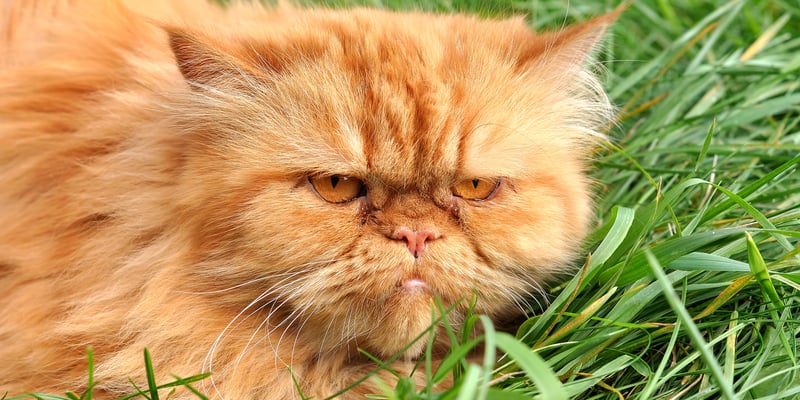Cat Weepy Eye - Runny Eye Causes and Treatments
Index:



Introduction
Maintaining good eye health is crucial for the overall well-being of your cat, as their eyes play a vital role in vision, communication, and expression. The early detection of potential eye issues is essential for ensuring a high quality of life for feline companions.
Weepy eyes in cats can signal various underlying problems, including infections, allergies, foreign bodies, conjunctivitis, or more serious conditions like glaucoma. Addressing weepy eyes promptly is important because it can impact a cat's well-being in several ways.
Weepy eyes often cause discomfort for cats, leading to irritation, redness, and inflammation. Cats may paw at their eyes or rub their faces against surfaces in an attempt to alleviate this discomfort. Excessive tearing can temporarily impair a cat's vision, affecting their ability to navigate their environment and potentially leading to accidents or injuries.
In this article, we're taking a closer look at how to address weepy eyes in cats, why consulting with a veterinarian is imperative and what a typical treatment programme looks like.
Understanding cat weepy eye



The tear film is a crucial component of cat eye health. It refers to the protective layer on the surface of the eye. Consisting of three layers -- an outer oily layer, a middle watery layer, and an inner mucous layer -- the tear film helps maintain ocular health by lubricating, nourishing, and protecting the cornea. It plays a vital role in preventing dryness, promoting clear vision, and defending against bacterial infections and viral infections.
Constant tears in cats can be attributed to various causes, highlighting the importance of a well-functioning tear film. Common factors include upper respiratory infections, which often result in increased tear production. Corneal injuries, such as scratches or abrasions, can also lead to excessive tear production as a protective response.
Blocked tear ducts may impede the proper drainage of tears, causing a buildup and subsequent overflow of tears. Eye infections, whether bacterial or viral, can provoke tear production as part of the body's defence mechanism. Physical injuries like corneal ulcers or the presence of foreign objects in the eye can induce tearing as the eye attempts to flush out irritants.
Symptoms and diagnosis



To manage mild weepy eye symptoms in cats at home, focus on cleanliness and minimising potential irritants. Use a soft, damp cloth to gently keep your cat's eyes clean by wiping away any discharge, ensuring it's free from harsh chemicals.
Maintain a clean living environment by regularly cleaning your cat's bedding and living spaces to reduce potential allergens. Avoid irritants such as strong cleaning agents, smoke, or dust that could worsen eye irritation.
Monitor the colour and consistency of the eye discharge and seek veterinary care if symptoms persist or worsen despite home care efforts. Don't hesitate to consult a veterinarian if your cat's behaviour changes, if there's a significant increase in discharge, or if there's evidence of an eye injury or trauma.
Regular veterinary check-ups are essential for monitoring your cat's overall health, including their eye health. When in doubt, consult with a veterinarian to ensure the well-being of your furry friend.
Professional treatments and interventions



The most common types of treatment prescribed by vets include:
Topical medications: Veterinarians may prescribe ointments or eye medication to address infections, inflammation, or irritations affecting the eyes.
Oral medications: In cases of systemic infections or infections, oral medications such as antibiotics may be recommended to treat the underlying cause.
Warm compresses: Applying warm compresses can help soothe mild eye irritations and promote drainage of excessive tear production.
Cleaning solutions: Veterinarians may recommend specific, gentle cleaning solutions to maintain eye hygiene and reduce discharge in cats.
Allergy management: If allergies are identified as a cause, veterinarians may suggest allergy management strategies, including dietary changes or antihistamines.
Surgical intervention: In severe cases, surgical procedures may be necessary to address issues such as blocked tear ducts or remove foreign objects.
Adhering to veterinary advice is crucial for managing weepy eyes in cats. Veterinarians provide a precise diagnosis through thorough examinations and diagnostic tests, addressing the specific cause of the issue and increasing the chances of successful outcomes with prescribed treatments.
Consistent adherence to the prescribed regimen is vital for optimal recovery, preventing complications, and reducing the risk of long-term consequences. Timely and appropriate treatment not only safeguards your cat's overall well-being but also helps prevent the progression of common eye conditions.
Regular veterinary check-ups enable the monitoring of progress and adjustments to treatment plans, ensuring ongoing care and minimising the risk of recurring issues. Effective communication with your veterinarian is key to achieving the best possible outcomes for your cat's eye health.
Prevention and long-term care



To prevent weepy eyes in cats, maintain a clean living environment by regularly cleaning their spaces such as litter trays and beds. Wipe away any eye discharge with a clean, damp cloth to promote good eye hygiene.
Identify and minimise exposure to potential allergens such as certain cleaning products to prevent allergic reactions leading to weepy eyes. We also recommend protecting your cat's eyes from sensitivity to light or wind exposure, especially in outdoor environments.
Regular veterinary check-ups play a crucial role in early detection and prevention of common issues such as weepy eyes. Veterinarians can identify subtle signs of pain or problems, enabling prompt treatment and reducing the risk of complications, ensuring overall eye health.
A healthy and balanced diet is fundamental for maintaining overall health, including eye health. Ensure your cat's diet is rich in essential nutrients, especially vitamins A and C, which support proper eye function. If you feel unsure, consult with your vet who will be able to help tailor a diet that meets your cat's nutritional needs, promoting optimal eye health and overall well-being.
As a Waggel member, you get 24/7 access to free online vet care with Joii. Simply download their app, choose Waggel as your insurance provider and connect to a vet in minutes.
Related health issues and weepy eye



Weepy eyes in cats can signify underlying conditions beyond ocular concerns. It may be linked to upper respiratory infections, allergies, conjunctivitis in cats, blocked tear ducts, corneal ulcers, dental problems, or systemic diseases. Weepy eyes should not be dismissed, as they may be a sign of infection. Regular veterinary check-ups play a crucial role in early detection and intervention to ensure the overall health and well-being of your cat.
As a cat owner, you can make full use of the Waggel blog any time you need it. Here you'll find lots of information on everything cat-related. From articles and advice on issues such as cat eye problems, feline sneezing, alopecia, neutering and spaying - we don't shy away from any topics.
Other articles such as feline diarrhoea and 'what to do if you identify blood in your cat's stool' recognise that whilst the pet ownership journey isn't always glamorous, your pet's well-being always comes first.
Conclusion
Understanding and managing cat weepy eyes involves recognising it as a potential common symptom of various health issues, including infections, allergies or dental problems. It's essential to be proactive in monitoring your cat's eye health, addressing any persistent symptoms promptly.
Practising good hygiene, maintaining a clean environment, and considering factors like allergies contribute to preventive care. Regular veterinary check-ups are crucial for early detection and tailored treatment, ensuring the overall well-being of your furry friend. By staying vigilant and seeking medical advice, you can play a vital role in maintaining your cat's eye health.
Having pet insurance such as Waggel is also a great option if you're worried about your pet's health and associated vet costs. Waggel members have access to a video vet 24/7 to help you with any worrisome issues and give you peace of mind.
FAQs
What are the most common causes of weepy eye in cats?
The most common causes of weepy eyes in cats include infections (bacterial or viral), allergies, blocked tear ducts, and corneal injuries.
How can I tell if my cat's weepy eye is a sign of a more serious condition?
Obvious signs of a more serious condition may include persistent yellow discharge, changes in your cat's behaviour (such as lethargy or decreased appetite), or visible eye injuries. If you observe any of these signs, it's advisable to seek veterinary attention for a thorough examination and diagnosis.
Can diet influence the health of my cat’s eyes?
Yes, maintaining a balanced and nutritious diet can positively influence the overall health, including eye health, of your cat. Essential nutrients like vitamins A and C, found in quality cat foods, contribute to proper eye function and help prevent potential eye issues. Consult with your veterinarian to ensure your cat's diet meets their specific nutritional needs.
Waggel Pet Insurance
Need more help? You're in luck if you're a Waggel Pet Insurance member. Along with our excellent coverage, we offer access to a 24/7 online vet to answer all your sticky questions, especially if you need grooming assistance.
Not a member? Why not get a quote now and cover your furry friend for a range of illnesses, all while enjoying our amazing perks and rewards.
Want more like this?
Get updates from us with helpful info, advice, answers to frequently asked questions and much more.
Index:
Related posts:
Get your quote
Along with our excellent coverage, we offer access to a 24/7 online vet to answer all your sticky questions.





